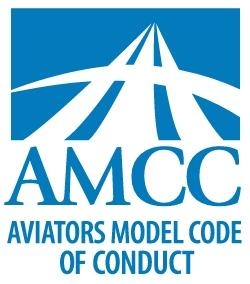Fri, Apr 06, 2012
Code Promotes Ongoing Improvements I Flying Quality And Safety
The Aviators Model Code of Conduct (AMCC)—Version 2.0 was released today by the project’s Permanent Editorial Board. Developed by a team of aviation professionals and drawing upon decades of research and experience, the Code promotes ongoing improvements in flying quality and safety. AMCC Version 2.0 reflects the knowledge and experience gained from extensive research, consultation, and draftsmanship of the many preceding versions.

Pilot conduct impacts the entire aviation community, including its safety culture. John King of the King Schools remarked, “This is a wonderful contribution to the aviation industry. Aviation safety is a matter of ethics. What pilots care about determines how well they manage the risks of flight.” A code of conduct can help any pilot develop a higher level of proficiency. The AMCC is just such a tool, a set of guidelines that is adaptable to each pilot and organizational need.
The AMCC:
- Promotes flight and ground safety, professionalism, and pilot contributions to the aviation community and society at large.
- Encourages the development and adoption of good judgment, ethical behavior, and personal responsibility.
- Supports improved communications between pilots, regulators, and others in the aviation industry.
The Code of Conduct has received extensive industry review and presents a vision of aviation excellence within its seven sections: (1) General Responsibilities of Aviators; (2) Passengers and People on the Surface; (3) Training and Proficiency; (4) Security; (5) Environmental Issues; (6) Use of Technology; and (7)
Advancement and Promotion of Aviation. The Code is a living document and will be periodically updated to reflect changes in standards, practice, and the aviation environment.
The Aviators Model Code of Conduct Version 2.0 is the latest in a family of similar codes including the Aviation Maintenance Technicians Model Code of Conduct, the Flight Instructors Model Code of Conduct, the Glider Aviators Model Code of Conduct, the Light Sport Aviators Model Code of Conduct, the Seaplane Pilots Model Code of Conduct, and the Student Pilots Model Code of Conduct. Developed as a volunteer effort, each is available as a free public service along with supporting materials online.
More News
Touchdown Zone Lighting Two rows of transverse light bars located symmetrically about the runway centerline normally at 100 foot intervals. The basic system extends 3,000 feet alon>[...]
“Discovery and innovation are central to our mission at Virgin Galactic. We’re excited to build on our successful record of facilitating scientific experiments in subor>[...]
"We are reaching out to you today on behalf of the Popular Rotorcraft Association because we need your help. We are dangerously close to losing a critical resource that if lost, wi>[...]
UAS Traffic Management (UTM) The unmanned aircraft traffic management ecosystem that will allow multiple low altitude BVLOS operations and which is separate from, but complementary>[...]
Aero Linx: Society of Aviation and Flight Educators (SAFE) SAFE is a member-oriented organization of aviation educators fostering professionalism and excellence in aviation through>[...]
 ANN's Daily Aero-Term (05.02.24): Touchdown Zone Lighting
ANN's Daily Aero-Term (05.02.24): Touchdown Zone Lighting Aero-News: Quote of the Day (05.02.24)
Aero-News: Quote of the Day (05.02.24) Aero-News: Quote of the Day (05.03.24)
Aero-News: Quote of the Day (05.03.24) ANN's Daily Aero-Term (05.03.24): UAS Traffic Management (UTM)
ANN's Daily Aero-Term (05.03.24): UAS Traffic Management (UTM) ANN's Daily Aero-Linx (05.03.24)
ANN's Daily Aero-Linx (05.03.24)



